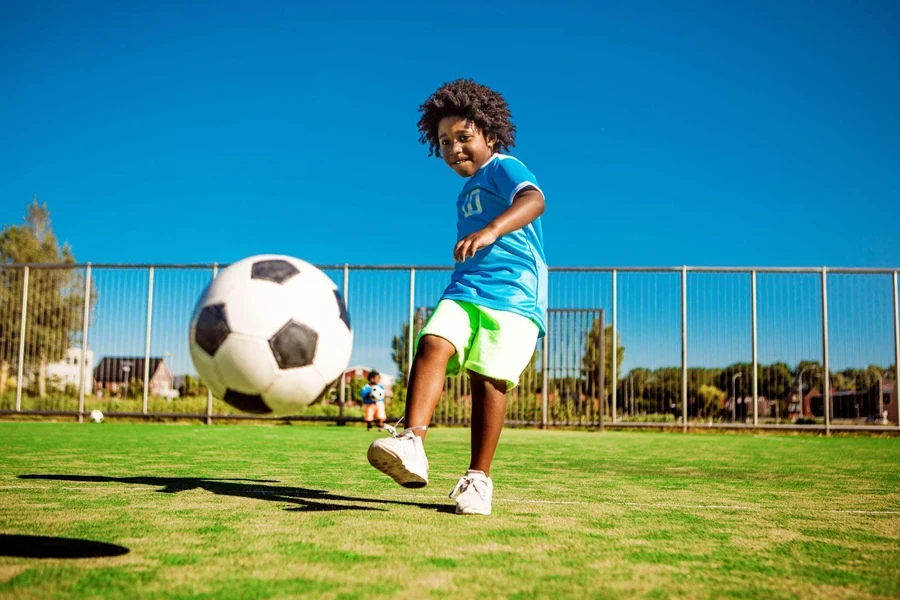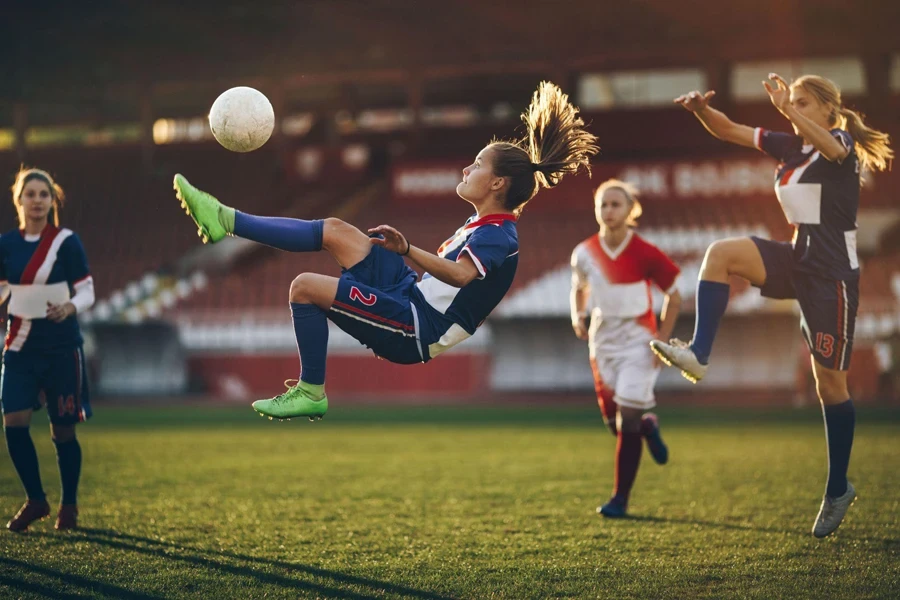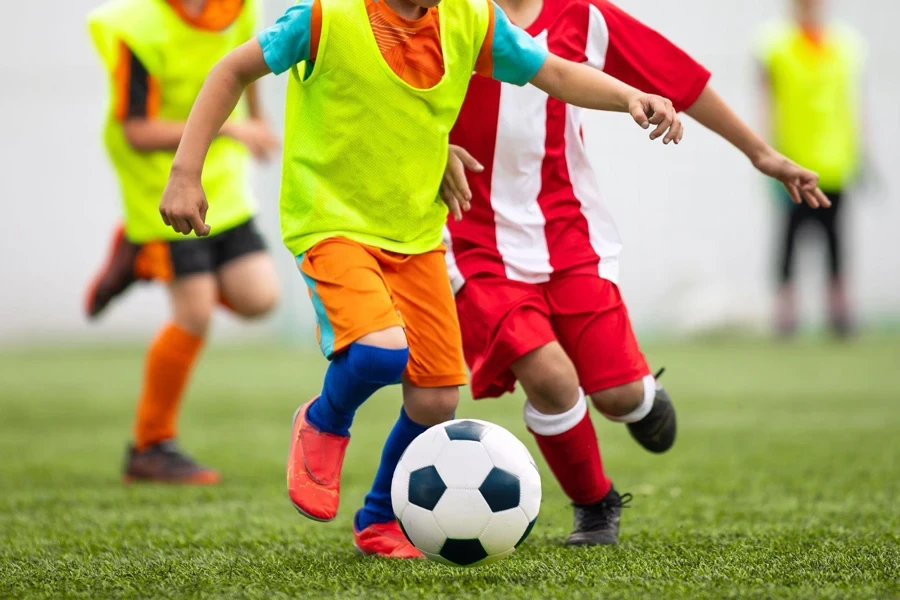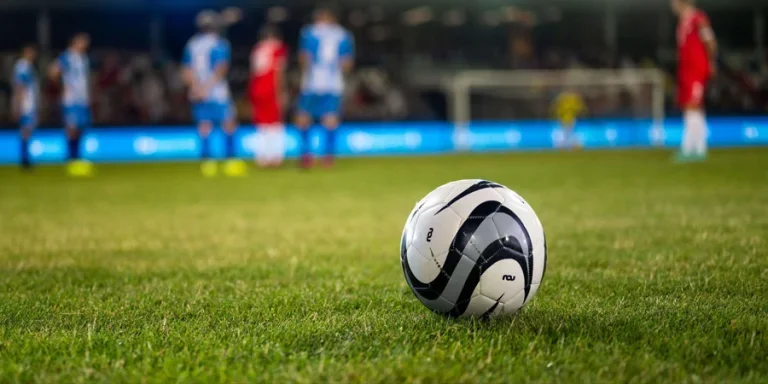Table of Contents
– Introduction
– Soccer Balls Market
– Soccer Ball Size Categories
– Age Guidelines for Soccer Ball Sizes
– Factors to Consider When Choosing a Soccer Ball Size
– Conclusion
Introduction
Choosing the right soccer ball size is crucial for young players’ development and enjoyment of the game. With various sizes available, it’s essential to understand which ball best suits each age group. This article will guide you through the different soccer ball sizes and provide age-appropriate recommendations to help you make an informed decision.
Soccer Balls Market
The global soccer balls market has shown robust growth in recent years, driven by the sport’s increasing popularity worldwide. According to recent market research, the market size was valued at USD 2,313.74 million in 2022. This substantial figure underscores the significant economic impact of soccer equipment, particularly balls, in the sports industry.
Looking ahead, the market is projected to experience steady expansion. Forecasts indicate that it will reach USD 3,630.82 million by 2027, growing at a compound annual growth rate (CAGR) of 9.31% during the forecast period. This growth trajectory reflects the sustained demand for soccer balls across various segments, from professional leagues to amateur and youth sports.
However, it’s worth noting that market projections can vary. A more optimistic outlook suggests the market could reach USD 27.6 billion by 2030, with an impressive CAGR of 24% from 2024 to 2030. While this projection appears significantly higher than others, it may account for potential market disruptions or expanded market definitions.
The soccer ball market is characterized by intense competition among key players, with companies like Adidas, Nike, and Puma holding significant market share. These industry leaders continually innovate in ball design and materials to maintain their competitive edge. The market is also influenced by major sporting events, such as the FIFA World Cup, which can drive sudden spikes in demand for official match balls and replicas.

Soccer Ball Size Categories and Age Guidelines
Size 1: Mini
– Circumference: 18-20 inches (46-51 cm)
– Weight: 5-7 ounces (140-200 grams)
– Use: Primarily for skill development and fun activities for young kids.
– Age Group: Ages 3-5 – Smaller balls like size 1 or 2 are beneficial for young children aged 3-5. These balls are easier to control and help kids build confidence as they learn basic soccer skills.
Size 2: Skills Ball
– Circumference: 20-22 inches (51-56 cm)
– Weight: 8-10 ounces (225-285 grams)
– Use: Designed for skill-building exercises and often used by young players or in small-sided games.
– Age Group: Ages 3-5 – Similar to size 1, these balls aid in skill development for very young children.
Size 3: Junior
– Circumference: 23-24 inches (58-61 cm)
– Weight: 10-12 ounces (285-340 grams)
– Use: Recommended for children aged 6-8 years old; used in training sessions and matches for this age group.- Age Group: Ages 6-8 – Using size 3 soccer balls promotes proper technique and ball control according to the United States Youth Soccer Association. They are well-suited for the physical development and skill level of this age group.

Size 4: Youth
– Circumference: 25-26 inches (64-66 cm)
– Weight: 12-14 ounces (340-400 grams)
– Use: Recommended for kids aged 9-11 years old; used in training sessions and matches for this age group.
– Age Group: Ages 9-11 – Transitioning to size 4 soccer balls helps players develop more advanced skills and prepare for the transition to adult-sized balls.
Size 5: Adult
– Circumference: 27-28 inches (69-71 cm)
– Weight: 14-16 ounces (400-450 grams)
– Use: Regulation size for players aged 12 and above, including professional adult players. Used in training sessions and official matches.- Age Group: Ages 12 and Above – Players aged 12 and above should use size 5 soccer balls, which are the regulation size for competitive play. According to FIFA, the official size 5 ball must have a circumference of 68-70 cm and weigh between 410-450 grams. Using the correct size ball helps players adapt to the demands of the game at higher levels.

Factors to Consider When Choosing a Soccer Ball Size
Physical Development
Consider the player’s coordination and motor skills when selecting a ball size. Younger children may struggle with larger balls, while older players may find smaller balls too easy to control. High-quality soccer balls designed for specific age groups can significantly impact player development and performance. Investing in age-appropriate balls ensures optimal skill progression and reduces the risk of improper technique formation.
Skill Level
Beginner players may benefit from using smaller balls to develop basic skills, while advanced players should use regulation-sized balls to prepare for competitive play. Professional-grade soccer balls with advanced construction techniques can enhance touch sensitivity and ball control for elite players. For academies and clubs, a range of ball sizes and qualities allows for tailored training programs that cater to various skill levels.
Training vs. Match Play
During training sessions, it may be appropriate to use smaller balls for specific skill-building exercises because they can enhance a player’s technical skills, particularly in areas of ball control, touch, and precision. Smaller balls, such as tennis balls, futsal balls, or size 3 soccer balls, require players to focus more intently on each touch, improving their ability to manipulate the ball with greater accuracy. This increased difficulty in controlling a smaller ball can lead to improved performance when transitioning back to a regulation-sized ball.
Specifically, smaller balls are beneficial for developing the following skills:
1. Close control: Using a smaller ball forces players to make more precise movements, enhancing their ability to keep the ball close to their feet.
2. First touch: The reduced surface area of smaller balls demands greater concentration and technique to receive and control the ball effectively.
3. Dribbling: Maneuvering a smaller ball improves a player’s agility and ball manipulation skills.
4. Passing accuracy: The increased precision required for smaller balls can translate to more accurate passing with regular-sized balls.
5. Juggling: Practicing with smaller balls can improve a player’s ability to keep the ball in the air, enhancing overall ball control.
6. Turning with the ball: The compact size of smaller balls can help players develop quicker and more precise turning movements.
7. Reaction time: The unpredictable bounce of smaller balls can improve a player’s reflexes and reaction speed.
It’s important to note that while smaller balls can be beneficial, they should complement rather than replace training with regulation-sized balls. Coaches should aim to incorporate smaller balls for specific drills or at the beginning of technical sessions, ensuring that the majority of practice still involves standard-sized balls to meet the demands of actual game situations.
Durable training balls with reinforced stitching and water-resistant materials can withstand intensive use, providing cost-effective solutions for high-volume practice sessions. Match balls with premium materials and FIFA-approved designs offer consistent performance and flight characteristics, crucial for official competitions and high-stakes matches.

Conclusion
Selecting the right soccer ball size is essential for player development and enjoyment. By following age-appropriate guidelines and considering factors such as physical development and skill level, coaches and parents can help young players reach their full potential. Remember, using the correct ball size not only enhances the learning experience but also prepares players for success at higher levels of competition.




